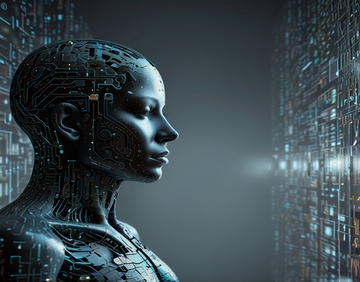Introduction: Beyond External Revolution
Our modern world obsesses over external revolution—technological disruption, social transformation, and systemic change. These external revolutions certainly matter, but they ultimately emerge from and return to a more fundamental source: our internal states of consciousness. As I've explored in my work and personal journey, our ultimate revolution is internal. It begins with paying attention—truly listening to ourselves, to each other, and to the subtle languages of the universe.
The relationship between technology and internal awareness presents one of the most fascinating paradoxes of our age. The same tools that can fragment our attention and disconnect us from ourselves also offer unprecedented opportunities for self-reflection, personal evolution, and expanded consciousness. From smartphone meditation apps to biofeedback devices, from journaling platforms to virtual reality consciousness exploration, technology can serve as both mirror and doorway to our interior landscapes.
This article explores the concept of internal revolution in a technological age, examining how digital tools can either obstruct or enhance self-awareness depending on their design and our relationship with them. Drawing from my experiences as both a technologist and someone deeply engaged with consciousness exploration, I'll discuss practical approaches to harnessing technology as a catalyst for personal transformation rather than distraction.
The Nature of Internal Revolution
The concept of internal revolution stands in stark contrast to our typical understanding of revolutionary change. External revolutions—whether political, technological, or social—attempt to transform structures outside ourselves. Internal revolution transforms the very foundation of how we experience and interact with reality.
Internal revolution operates through several key mechanisms:
Mechanisms of Internal Revolution
Self-Awareness and Observation
The foundation of internal revolution is the capacity to observe ourselves without judgment—to witness our thoughts, emotions, and behaviors from a perspective of awareness rather than identification. This "witnessing consciousness" creates space between experience and identity, allowing for true choice rather than automatic reaction.
Pattern Recognition
As we develop self-observation, we begin to recognize recurring patterns in our thinking, feeling, and behaving—often patterns that have operated unconsciously for decades. These patterns form the invisible architecture of our experience, shaping how we perceive and respond to reality.
Conscious Rewiring
Once patterns become visible, they become available for conscious modification. Internal revolution involves intentionally rewiring neural and psychological patterns that no longer serve our growth or well-being.
Integration of Shadow
Perhaps most challenging and powerful is the process of recognizing and integrating disowned or rejected aspects of ourselves—what Jung called the shadow. Internal revolution requires facing what we've denied, transforming opposition into wholeness.
These processes aren't merely psychological self-improvement but fundamental shifts in how consciousness organizes and experiences reality. The ultimate outcome isn't just becoming a "better person" but experiencing a qualitatively different relationship with existence itself.
In my own journey, internal revolution began in earnest after my coma experience, which created a profound discontinuity in my perception of self and reality. This discontinuity made previously invisible patterns suddenly visible, allowing me to recognize how my consciousness constructed experience rather than merely received it.

Technology as a Mirror for Self-Awareness
Technology can function as an extraordinary mirror for self-awareness when thoughtfully designed and consciously used. This mirroring function operates through several mechanisms:
Mechanisms of Technology as a Mirror
Data Reflection
Technologies that track our behaviors, attention patterns, emotional states, and physiological responses can reveal patterns we might otherwise miss. From screen time analytics that show where our attention goes to heart rate variability measurements that indicate stress responses, these data points offer objective feedback about our internal states.
Interaction Patterns
Our interactions with technology often reveal unconscious patterns. Do we compulsively check devices when uncomfortable emotions arise? Do certain content types trigger specific emotional reactions? These patterns become visible through mindful observation of our technological behaviors.
Created Content Analysis
The content we create and share digitally—from social media posts to personal notes—provides insights into our preoccupations, values, and emotional states. AI-powered text analysis can identify emotional patterns, cognitive biases, and recurring themes we might not consciously recognize.
Virtual Identity Construction
Our digital avatars and online personas often reveal aspects of self that may be suppressed or unexpressed in physical life. The gap between physical and digital self-presentation creates valuable opportunities for self-inquiry.
I've experimented extensively with technology as a self-awareness mirror, developing custom tools to track my attention patterns, emotional states, and cognitive biases. These experiments revealed surprising patterns—for instance, how certain physical environments consistently shifted my thinking style, or how specific digital interactions reliably triggered particular emotional responses.
However, technology only functions as an effective mirror when we approach it with conscious intention. Without this intention, the same tools that could enhance self-awareness often become mechanisms for self-distraction or self-deception. The distinction lies not in the technology itself but in our relationship with it.
Attention: The Currency of Consciousness
If internal revolution begins with paying attention, then attention itself becomes the primary currency of consciousness—more valuable than time or money. Yet in the digital age, attention has become the most aggressively harvested and commercially exploited resource. Understanding and reclaiming attention is therefore central to internal revolution in a technological society.
Several key principles govern attention's relationship to consciousness:
Principles of Attention
Attention Direction Shapes Experience
What we attend to quite literally becomes our reality. The objects of our attention expand in our awareness, while what we ignore effectively ceases to exist for us subjectively. This creates a profound responsibility for choosing the direction of our attention.
Attention Quality Determines Insight
Beyond simply where we place attention, how we attend matters enormously. Fragmented, anxious, or concept-driven attention yields fundamentally different insights than sustained, open, presence-based attention.
Attention Habits Form Identity
Over time, our patterns of attention literally construct our sense of self and world. We become what we repeatedly attend to, as neural networks strengthen around objects of regular focus.
Attention Exchange Creates Value
When we exchange attention with another conscious being—human or artificial—we create the foundation for meaningful connection and value creation. This exchange represents the fundamental unit of conscious relationship.
Technology creates unprecedented challenges and opportunities for attention management. Digital environments often engineer fragmented attention through interruption, variable reward, and algorithm-driven content delivery. Yet these same environments can be redesigned to support sustained, self-directed attention through thoughtful interface design, notification management, and attention-enhancing features.
In my experience, speed actually enhances rather than diminishes attention quality. When moving or thinking rapidly—driving at high (but safe) speeds, processing information quickly, engaging in rapid problem-solving—my focus actually sharpens and expands simultaneously. This counterintuitive relationship between speed and attention quality suggests that our conventional assumptions about "slowing down" for better focus may sometimes work against our cognitive architecture.
Digital Tools for Self-Knowledge
An emerging ecosystem of digital tools specifically designed to enhance self-knowledge and internal awareness challenges the narrative that technology inevitably diminishes consciousness. These tools fall into several categories:
Categories of Digital Tools
Meditation and Mindfulness Technologies
Applications that guide meditation practice, measure neural states associated with mindfulness, and create environmental conditions conducive to present-moment awareness. Advanced versions use biofeedback to create closed-loop systems where physiological data influences the meditation guidance.
Emotion Tracking and Regulation Tools
Systems that help identify emotional patterns through natural language processing, facial expression analysis, voice tone evaluation, and physiological markers. These tools can reveal emotional blind spots and provide real-time support for regulation techniques.
Cognitive Bias Recognition Systems
Applications that analyze decision patterns, information consumption, and communication to identify cognitive biases operating outside awareness. These tools help recognize how our thinking systematically deviates from rationality or objectivity.
Consciousness Exploration Environments
Virtual and augmented reality environments specifically designed to facilitate exploration of consciousness states. These range from immersive meditation environments to more experimental spaces that alter perception in ways that reveal aspects of consciousness typically hidden from awareness.
Digital Phenotyping
Systems that analyze patterns in our digital behavior—typing speed, movement through interfaces, language use, interaction timing—to identify changes in cognitive and emotional states that might indicate important psychological shifts.
In my work developing AI assistants like EMMI, I've focused on creating tools that enhance rather than replace human consciousness. The goal isn't artificial consciousness that mimics human awareness, but symbiotic systems that extend and amplify our native awareness through complementary capabilities. This approach views technology not as a replacement for human consciousness but as a partner in its evolution and expansion.
Pain as a Teacher: Technology and Emotional Processing
One of the most promising yet challenging frontiers in technology-assisted internal revolution involves emotional processing—particularly related to pain and suffering. In our quest for comfort, we often use technology to numb or escape difficult emotions, yet these same emotions contain essential information for our growth and transformation.
Technology can support healthy emotional processing through several approaches:
Approaches to Emotional Processing
Emotional Physicalization
Systems that help identify and locate emotional responses in the body through guided attention and biofeedback. This counteracts the modern tendency toward emotional dissociation by reconnecting emotional experience with its physical substrate.
Narrative Restructuring Tools
Applications that help identify limiting narratives about painful experiences and facilitate construction of more empowering interpretations. These tools support the transformation of suffering into wisdom by changing our relationship with difficult experiences.
Exposure Calibration Systems
Technologies that provide carefully calibrated exposure to emotional triggers in safe environments, supporting gradual processing of difficult experiences. These systems can help navigate the optimal zone between overwhelm and avoidance.
Meaning-Making Frameworks
Digital frameworks that help extract meaning and purpose from painful experiences by connecting them to larger values, goals, and evolutionary perspectives. These tools transform isolated suffering into meaningful elements of a larger life story.
Through my own recovery from trauma and coma, I've explored how technology can support transformation of suffering into wisdom. I've found that technology functions best as a container and facilitator for emotional processing rather than a replacement for direct experience. The goal isn't to eliminate pain but to develop a different relationship with it—seeing pain as a teacher rather than an enemy.
As I've written previously: "Pain is not a punishment but a teacher. Suffering is not a life sentence but a temporary state of disconnection." Technology can help us maintain this perspective by creating conditions for productive engagement with difficult emotions rather than endless distraction from them.

Integration: Balancing Internal and External Worlds
The ultimate challenge of internal revolution in a technological age involves integration—maintaining connection with our interior landscape while actively engaging with the external world. This integration requires a balance often missing in both traditional spiritual approaches (which sometimes retreat from external engagement) and technological solutionism (which often ignores interior dimensions).
Several principles guide successful integration:
Principles of Integration
Permeable Boundaries
Maintaining flexible rather than rigid boundaries between internal and external focus, allowing appropriate movement between states of self-reflection and world engagement. Technology can either reinforce or dissolve these boundaries depending on its design and use.
Rhythmic Alternation
Recognizing that consciousness naturally moves in rhythms between internal and external focus. Technology can either support or disrupt these natural rhythms, with significant implications for well-being and functioning.
Contextual Appropriateness
Developing sensitivity to which state—internal or external focus—best serves a particular context. Different environments and activities benefit from different attention allocations.
Simultaneous Awareness
Cultivating the capacity for dual awareness that maintains connection with internal states while engaging externally. This parallels what meditation traditions call "mindfulness in activity."
In my own work creating AI tools, I've focused on how technology can support this integration rather than forcing artificial choices between internal and external focus. For example, the PromptSage framework described in earlier articles deliberately incorporates ethical guidelines at the highest level of its architecture, ensuring that technical systems remain connected to human values.
The tools we create—whether AI assistants or educational platforms—are reflections of the worlds we wish to build. By starting with self-awareness, we can channel technological creativity into systems that uphold rather than undermine our humanity—tools that expand consciousness rather than contract it.
Conclusion: Seeding a Compassionate Future
"We harvest what we seed." This simple truth applies as much to consciousness as to agriculture. If we seed fear, we harvest hatred—a pattern clearly visible in much of our current technological and social landscape. But if we seed awareness, connection, and compassion, we can harvest a fundamentally different future.
Internal revolution isn't opposed to external change but forms its necessary foundation. Without transformed consciousness, even the most promising technological and social innovations inevitably reproduce the same patterns of suffering and limitation. With transformed consciousness, even imperfect systems can become vehicles for human flourishing.
The technological tools we've developed offer unprecedented capacities for both consciousness expansion and contraction. The determining factor isn't the technology itself but the consciousness that designs and uses it. This places enormous responsibility on those creating technological systems to cultivate their own internal awareness, ensuring that what they create emerges from and supports expanded rather than contracted consciousness.
For those of us engaging with technology—which now includes virtually everyone—internal revolution requires conscious relationship with our tools. This means using technology in ways that enhance rather than diminish awareness, connection, and compassion. It means choosing tools designed to support human flourishing rather than exploit human vulnerability. And it means maintaining sovereignty over our attention rather than surrendering it to algorithmic manipulation.
Knowledge is power, but wisdom is liberation. And liberation begins with a single, courageous act of seeing beyond the constructs that limit us—whether those constructs are technological, social, or psychological. By cultivating internal revolution in a technological age, we create the possibility of technologies that serve rather than subvert human potential—tools that help us become more fully human rather than less so.
We are not here merely to survive. We are here to evolve. And that evolution happens first and most fundamentally within.





